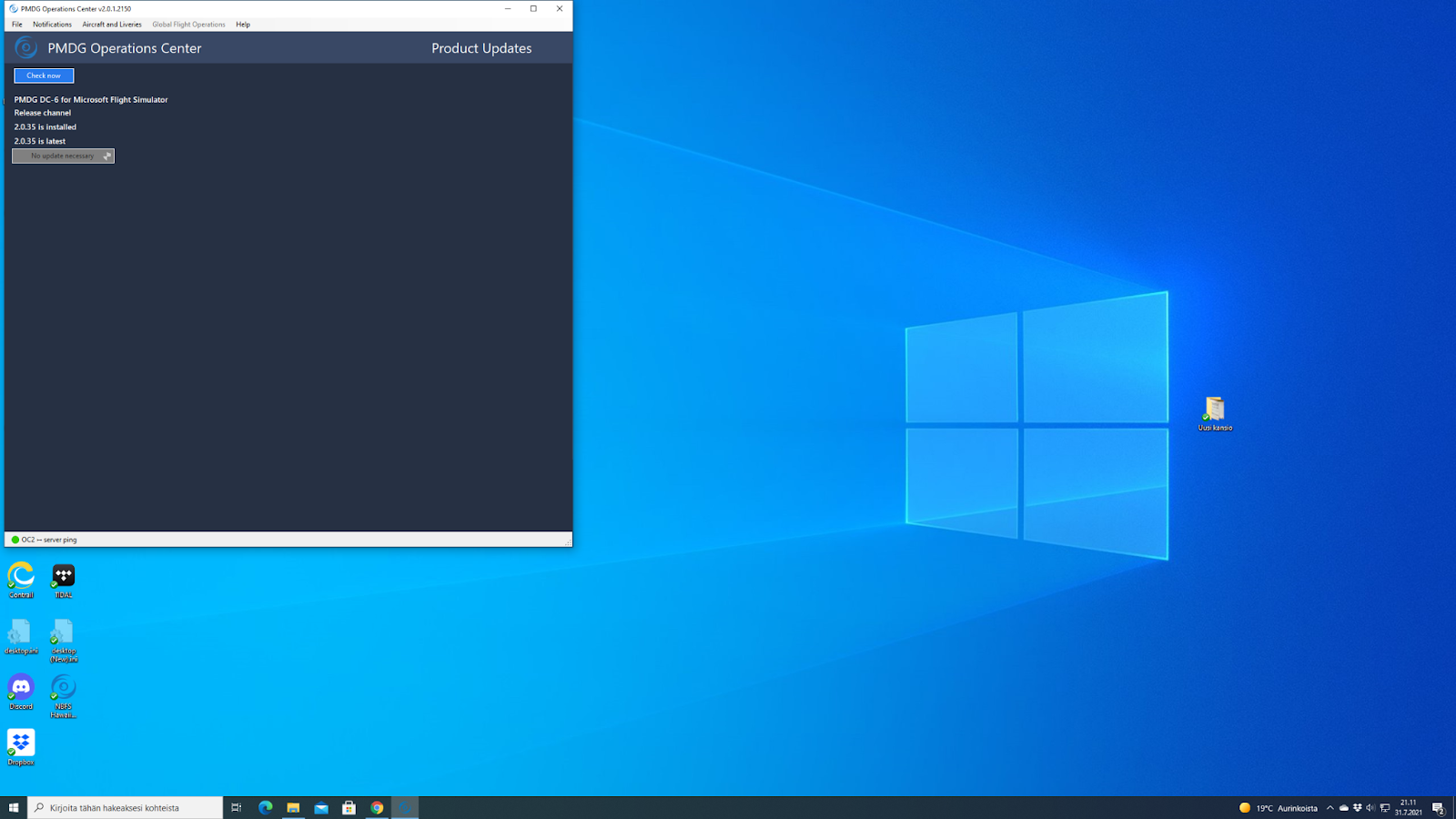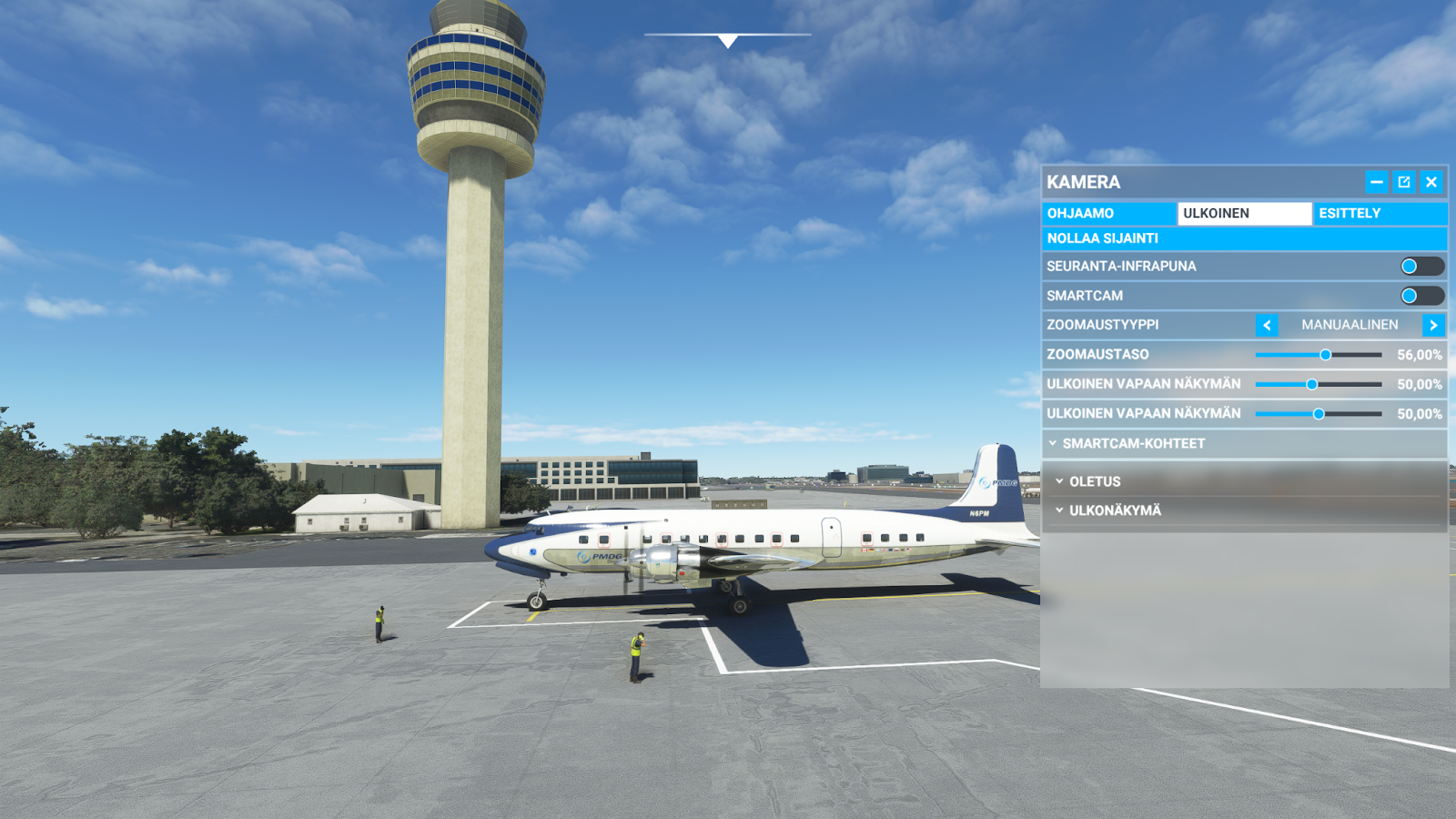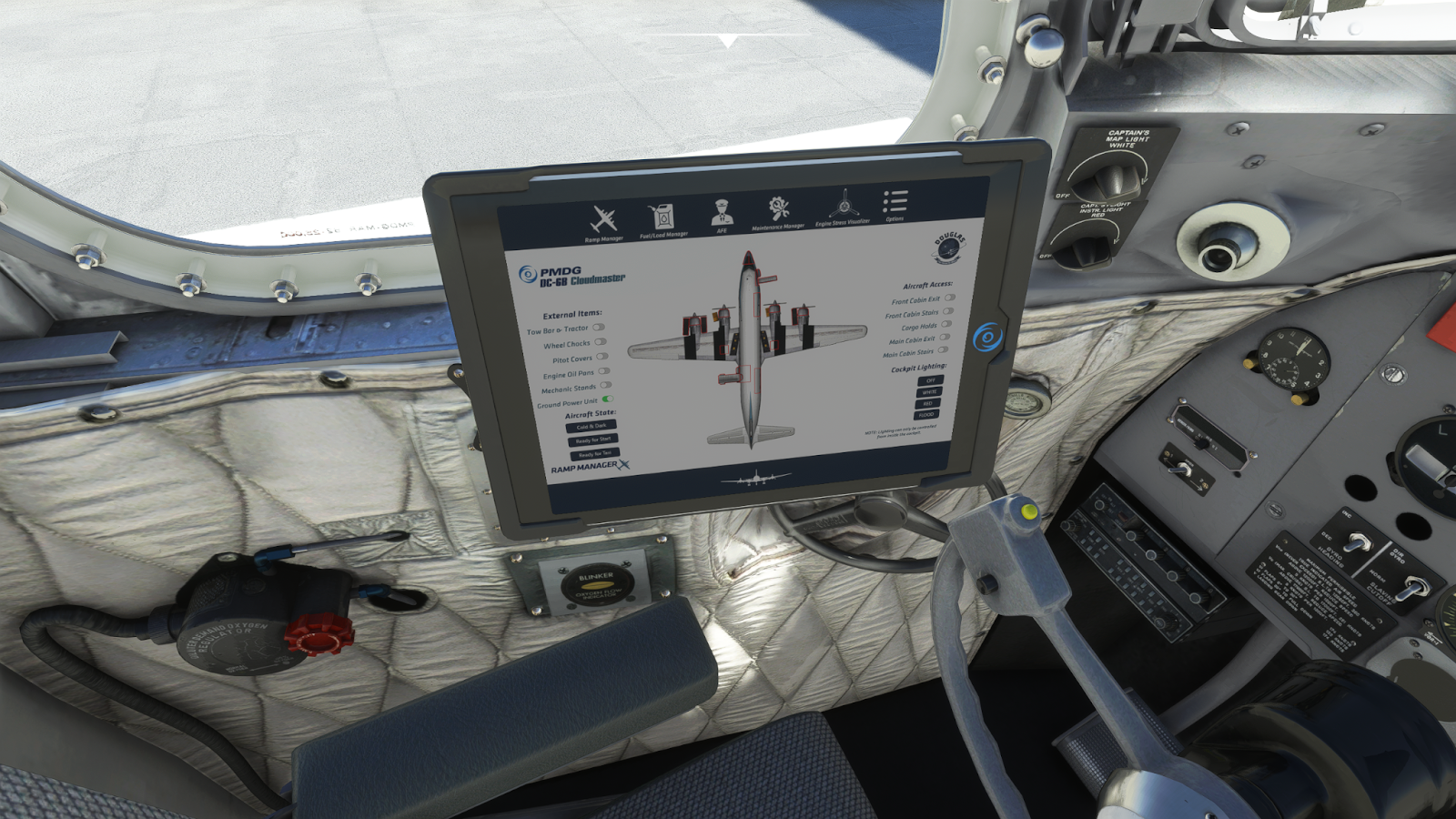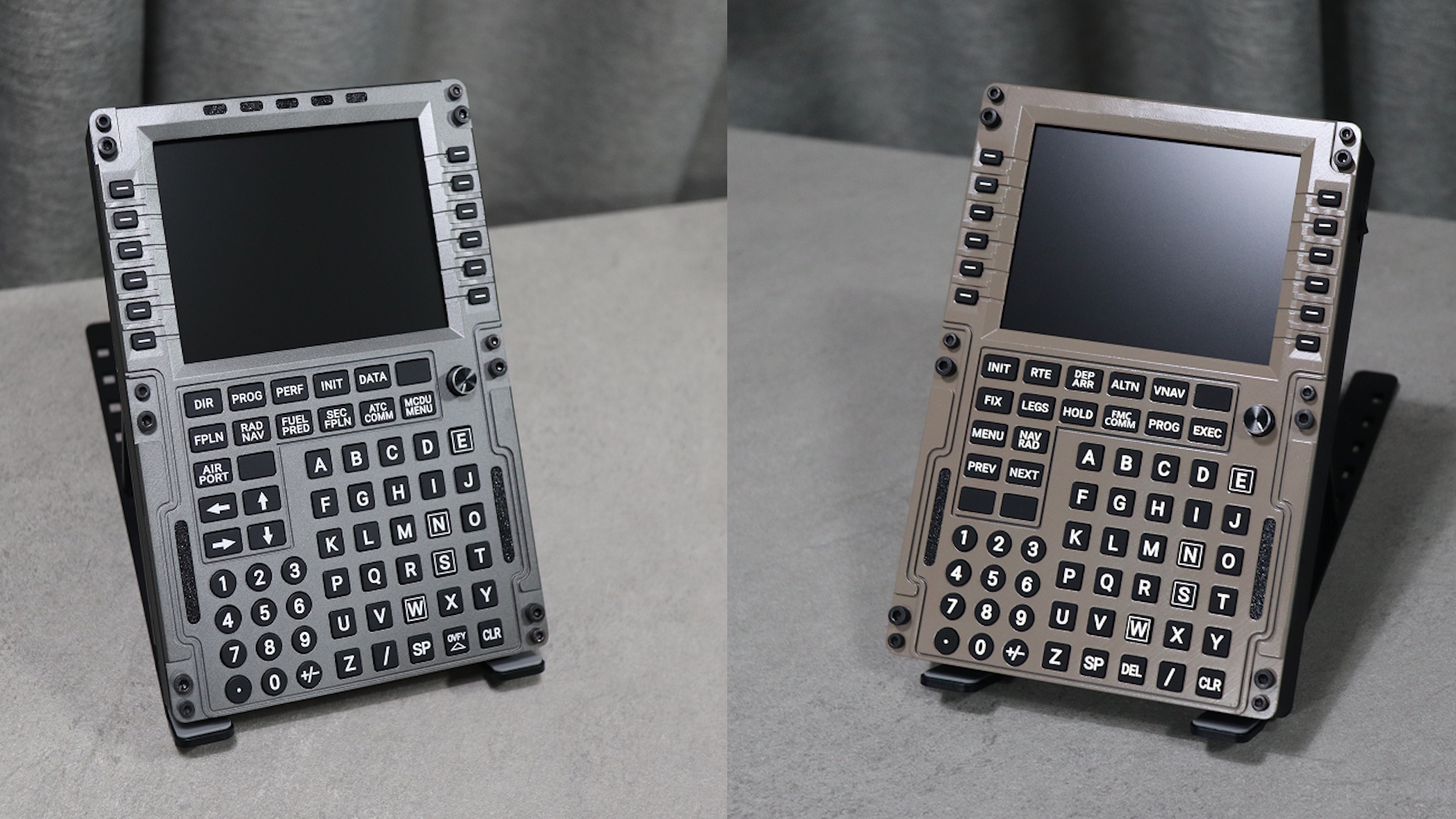Threshold Review: PMDG DC-6 for MSFS
August 18, 2021
The release of the PMDG DC-6 was touted by many as a turning point in the history of Microsoft Flight Simulator, seen as definitely proving that a study level airplane is now possible on the new platform.
The DC6 was designed by Douglas as a wartime personnel transport in 1946, however, never got to serve in that role and was quickly repurposed for airline operations after World War II ended. As one of the first pressurised transport category airplanes, it competed against the likes of the Convair CV-440 Metropolitan and Lockheed Constellation.
PMDG’s rendition itself has a somewhat convoluted history. Originally introduced as a sort of vanity project for the legacy ESP platforms, the DC-6 was realigned for release on X-Plane and designated PMDG’s testbed for their ill-fated entry into the X-Plane space. Released on June 1, 2016, the original X-Plane 10 version failed to impress and updates to it were quickly discontinued, as was PMDG’s entire X-Plane foray. After subsequent re-release on FSX/P3D, it was now released a third time for MFS.
As with the previous releases, the package contains two aircraft, the DC-6A and DC-6B. PMDG’s DC-6 projects are based on research and photography aboard V5-NCG, a Namibian presidential aircraft, and, incidentally, also the last DC-6 off the production line. Both the A and B are enhanced versions of the original DC-6, with the A being a cargo variant and the B being an all-passenger variant.
Installation and documentation
Installation was effortless using the executable downloaded from PMDG after purchase, as of 25JUL21 the initial download size is 530 MB. I did encounter a brief issue where the Operations Center was failing to install, but PMDG quickly provided me with a separate installer for the companion software. The documentation consists of an Introduction document, mostly to do with sim-related issues (such as how to optimally configure the simulator for the DC-6), and an Operations Manual, a condensed version of the real manufacturer’s flight manual. Two thorough tutorials are also provided. In addition, PMDG provides a set of high-quality YouTube videos to assist especially users new to piston-powered airliners. Despite the (for PMDG) unconventional subject matter, you could say this is the most accessible PMDG product yet.
Like all PMDG products since 2009’s Jetstream 41 for FSX, the MFS version of the DC-6 also comes with the aforementioned PMDG Operations Center. The Operations Center is a management frontend application that lets you install liveries (both PMDG-created and custom-made ones specifically packaged in the proprietary PTP format), as well as install product updates as those are released by PMDG. I must say that the current version of the OC is not quite as versatile as the previous version, which had quite a lot more functionality, such as easy access to manuals. I don’t know why PMDG decided to remove these functions, but it is certainly a disappointment.

External visuals
The external model is a big step up from PMDG’s previous outings, and promises good tidings for the outfit’s upcoming MFS products, such as the much-discussed NG3, however, in contrast to the NG3, the DC-6 in most visual metrics is primarily a textural update, adopting essentially the same model created for an old ESP simulator, but subsequently released for X-Plane 10 over half a decade ago, on June 1st 2016 From there, you can definitely see visible concessions made to the detailing of the aircraft, it stood well against the test of time, but its approach to modelling is dated. The refreshed DC-6 external model has PBR and material reflections written all over it, and despite the purely texture upgrade, it is a great example of MSFS material harnessed properly, and may be considered a statement regarding the graphics capabilities of MFS. That said, there are areas, such as the wheel wells close up, where not quite as much love has been given, but these are possibly intentional concessions for performance purposes, reflecting the age of the 3D modelling.


Speaking of the liveries available via the OC, they are good but not stellar. Should you be inclined toward making your own liveries, the PMDG paint-kit is a good effort and now allows even certain flight deck visual elements to be customised, such as the logo on the yoke. The same goes for the textures on the ground utility vehicles. Boeing’s (who also owns Douglas’ IP) licensing policies have usually been too restrictive to allow for officially-sanctioned modifications that alter the flight deck depiction in any way (which, of course, isn’t to say such mods don’t exist, you just have to know where to look), so it’s nice to see they’ve had a change of heart in the case of this old girl. Above is a shot of a historical Finnish livery commissioned by yours truly, and shows how you can get really creative if you feel so inclined.
Something that’s a bit of a letdown (for me, anyway) are some of the external animations, which have some weird discontinuities to them: by way of example, the rear stairs just magically lock into place, with obvious shortcuts having been taken in animating their deployment.
Flight deck visuals
The aircraft really shines here. The various controls and indicators have an appropriate level of wear to them for a 50s-60s mainline airplane, which is nice to see. The texturing is top notch throughout. A particular high point is the 3D modeling of the indicator hands on the various round-dial gauges. All instrument decals are easy to read, which further adds to the immersion. Impressively, all artificial lighting sources on the flight deck have been modeled so as to be individually controllable, which makes for a highly authentic feel, particularly at night.


The flight deck animations are also really smooth, and reflect the movement of the actual controls very nicely. Besides the controls, various ancillary items have also been animated -- a high point is the ability to open the flight deck windows, a feature that still isn’t standard-issue in 2021. A nice touch is the folding supernumerary crew member’s chair -- the real aircraft’s type certificate allows for either two or three-crew operation, so you can configure the seats as you wish for the operation you are simulating. The circuit breaker panel is also fully animated and operational, with each breaker properly connected to the appropriate electrical consumer -- we’ll touch on this more deeply below
Outside the flight deck itself, there is a (static) equipment rack as well as a storage rack for the crew’s personal items. Some animations here could perhaps have been nice, especially since there are presumably less limits on the amount of animations than there were in the earlier versions of the simulator.
Cabin visuals

The cabin is okay -- but no more than that. Both textures and geometry have been ruthlessly simplified. I get that cabins are not PMDG’s focus area, but if some recent cries in their forums are anything to go by, that is no longer an acceptable excuse in Asobo’s simulator. The platform now finally allows for the total immersion the community has been longing for, and if PMDG wants to be on top of their game, the situation ought to change with the NG3.
Developers need to realise that aircraft in MFS are no longer simple bolt-on modules -- rather, they should be viewed as environments, and that includes the cabin. Especially with the wider-than-ever market appeal of the new simulator, a single area of the overall user experience can no longer afford to stand out as lacking. Some recent offerings for modern simulators, such as the upcoming Q4XP for X-Plane 11, have even begun to feature working cabin ancillary interfaces, such as flight attendant panels. In the new design philosophy, then, the cabin is viewed as an integral part of the user experience of a high-fidelity add-on airplane. The PMDG offering is really more of an afterthought.
Systems and avionics
This is, of course, the meat and potatoes of any PMDG product, and I’m pleased to report that PMDG has done a mostly excellent job representing this radial beast. This is probably the best place to discuss the in-cockpit tablet that PMDG provides with the airplane. For users of previous versions of the DC-6, you will recognise the menu layout as almost identical to what was previously offered via pop-up interfaces: you can open and close doors, set aircraft mass and balance, perform maintenance actions such as topping up fuel and other consumables.
This is also where you interact with the Artificial Flight Engineer, which performs a function similar to add-ons such as FS2Crew and Multi-Crew Experience in previous simulators, in allowing any normal checklist to be automatically performed via a few clicks of the mouse. This feature is also an as-is carryover from the legacy releases. It’s a great tool for learning the airplane, but on the other hand, all the flows are rigid and not customisable to fit different operators’ procedures for flying the airplane -- but this, of course, is a gripe of minor nature. The tablet also lets you configure realism options for spontaneous electrical failures, carb icing, engine damage and realistic start, which causes the engine to require much more precise handling for starts to be successful.

A high point for the X-Plane edition was that it was the first PMDG product with operable circuit breakers. This feature returns in MFS, and allows you to really get into the nitty gritty of the electrical system. Some operators would also require use of the CB panels during certain normal procedures, such as an engine start from the aircraft battery, to disconnect surplus electrical loads to avoid unnecessary electrical transients. There were initially some bugs in the electrical system inverter priority logic, but those have been fixed in recent patches. If you have electrical failures enabled, be sure to scan the CB panel before and during flight -- you just might get a pop.
The hydraulic system is similarly detailed and is powered by two engine-driven main pumps and one electrically-driven emergency pump. Although there are apparently no bespoke hydraulic failures, losing an engine will indeed affect your hydraulic pressure and you might have to rely on the emergency system.
Speaking of engine modeling, it is good, but not as insanely detailed as with the A2A classic airliner products. Still, if you have the appropriate realism options enabled, manhandling the engines will cause them to fail and/or catch fire, and you’ll be knee-deep in the emergency procedures once again! You’ll also find the DC-6 has, for its time, some rather sophisticated systems for managing the props, with the associated tests having been fully modeled, in addition to run-up-related indications.
Sounds
On my Genelec system, the sounds seem well detailed and balanced. There’s some sputtering from the engines if you mismanage the mixture. All the controls also have rich sounds associated with them. The Wwise sound engine allows for some precision tuning of the stereo image, and that shows here.
Even the engine resonance in the appropriate RPM range has been modeled, and will cause the entire flight deck to shake. PMDG also recently issued a patch that makes the automatic flight engineer clearer to hear.
Flying the DC-6 -- with a twist
I had the chance to talk to a DC-6 veteran, Captain Matti S. about his experience flying the DC-6. Here’s what he had to say:
“The DC-6 was really one of the last airliners to precede the human factors revolution in commercial aviation. You’ll see controls scattered around the flight deck in a way that sometimes seems to defy logic. Both the Caravelle 10B3 and the DC-9 I subsequently flew were significant improvements in this regard. You’d also have to watch the engines like a hawk, or you could get your butt burnt real fast.”
This is really what typifies the PMDG DC-6 experience as well: if it weren’t for the AFE, this would probably not be a very beginner-friendly airplane. Once you do manage to trundle your way to the runway, you’ll encounter the next difference -- the takeoff performance.
“I remember being floored when observing a lightweight Caravelle takeoff for the first time and seeing a 4000 fpm rate of climb. You really can’t expect that with the DC-6.”
Indeed, this was the era before swept wings and powerful engines, and your initial climb performance will be lacklustre by modern standards. You’ll gradually reduce to climb power, and will have to learn to use the engine superchargers to retain enough energy to make it to cruise.
Another interesting gizmo you’ll find aboard is the Sperry A-12 automatic pilot, which is commonplace on the DC-6. The controls are on the pedestal, with three main modes: gyropilot, which is basically a glorified attitude hold that lets you turn the airplane by means of a turn-knob or use a selector wheel to command a climb or descent, localiser, which tracks a localiser or VOR course, and approach, which tracks an ILS.. There is also an altitude hold mode, but no provision to preselect altitudes: you’ll have to switch the mode on upon reaching the desired altitude. Interestingly, altitude hold was the only mode permitted by many operators, as autopilots hadn’t yet gained enough traction to be considered trustworthy for the full flight profile.
In the air, the DC-6 does about as good a job as possible simulating inertia as is possible without control loading, which most users won’t have. There’s some of the pitch axis sensitivity that plagues all MFS flight models, but I predict Asobo will fix this in time. Incidentally, pitch sensitivity (or apparent pitch sensitivity) is also a feature of professional full-flight simulators, even when the device is provably being fed with flight-test data. The theory behind this is beyond the scope of this article, but it sets some expectations with respect to how perfect the flight model should be expected to be, when professional devices costing millions of dollars have the same issue.
Descent is also very different from a swept-wing jet in that you’ll typically be doing a very shallow descent at about 500 feet per minute. The aircraft sheds energy slowly, which has been well simulated. Because the radial engines don’t like having their power settings changed, you’ll have to know how to optimally set power and hold it almost to the runway. You don’t really flare either, just keep flying it till you touch down. There are also no speedbrakes, so you’ll have to use the flaps to slow down.
Performance
I get an average of about 30fps on the ground and about the same inflight. Interestingly, in my case the performance seems to be improved by night-time conditions. I have a reasonably beefy system (Ryzen 3700X with 32GB RAM, RTX 2080 Super series GPU), so your mileage may vary. I had some graphics glitches after Sim Update 5, but recent hotfixes by both PMDG and Asobo seem to have rectified most of these. Overall, I was positively surprised by the smoothness of the performance throughout.

Verdict
PMDG were the first to the study-level MFS market and as such they get to set the tone here. It’s not *really* a ground-up rebuild, but why should we have assumed so? PMDG may well be saving something for the NG3. Apart from the visual model being somewhat lacklustre (comparatively speaking to the likes of CaptainSim or the upcoming Fenix A320), the PMDG DC-6 for the most part, stood the test of time way back from its inception in its early ESP days. But where the product truly shines is PMDG's primary forte: an enriched and deeply simulated systems experience (for a "lite" PMDG product, this is no NG3), with a great flight deck to boot. In addition, the flight modelling is well done, for a MFS debut anyway.
Purchase the PMDG DC-6 for $59.99.
Share this page
COMMENT ADVISORY:
Threshold encourages informed discussion and debate - though this can only happen if all commenters remain civil when voicing their opinions.












